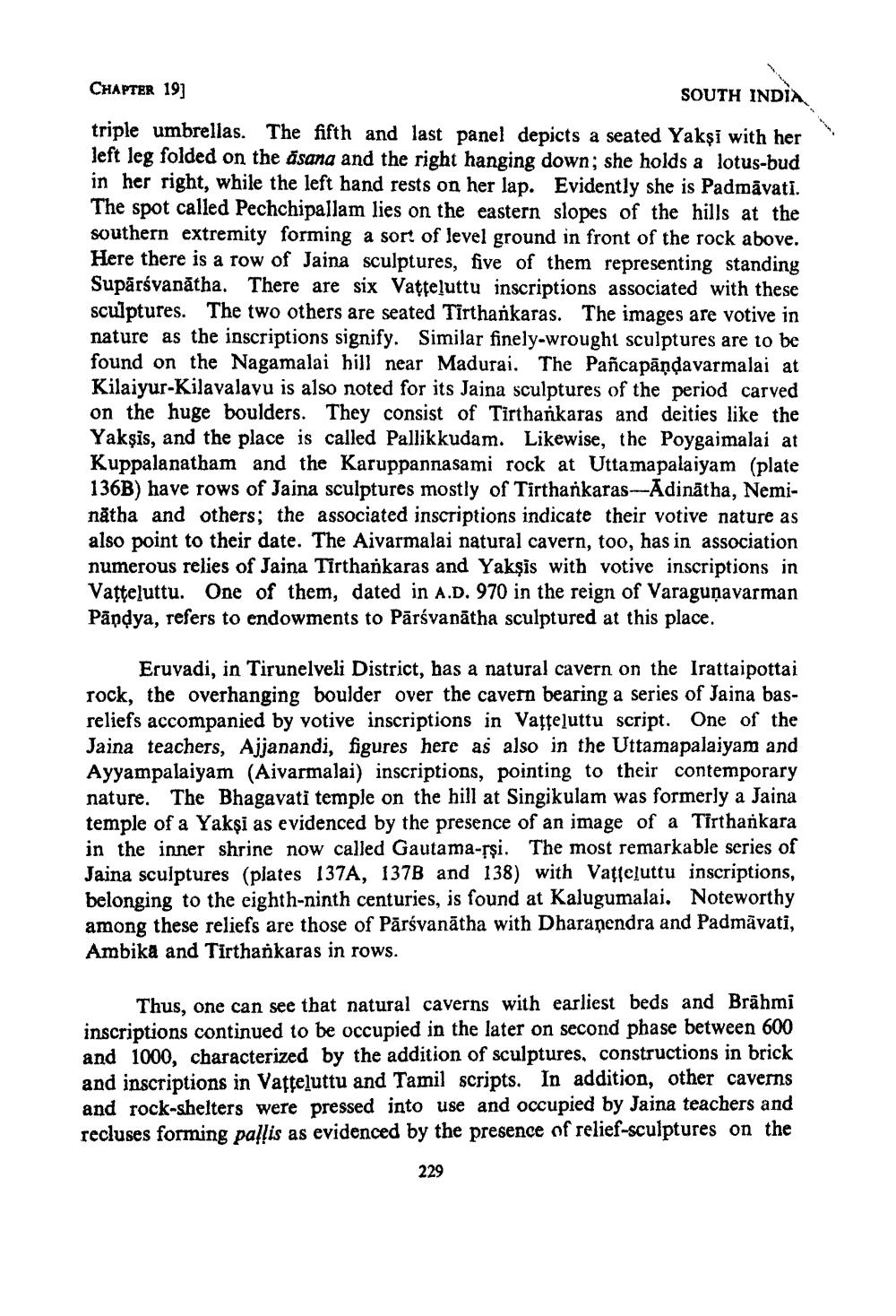________________
CHAPTER 19]
triple umbrellas. The fifth and last panel depicts a seated Yakşi with her left leg folded on the asana and the right hanging down; she holds a lotus-bud in her right, while the left hand rests on her lap. Evidently she is Padmavati. The spot called Pechchipallam lies on the eastern slopes of the hills at the southern extremity forming a sort of level ground in front of the rock above. Here there is a row of Jaina sculptures, five of them representing standing Supärśvanatha. There are six Vatteluttu inscriptions associated with these sculptures. The two others are seated Tirthankaras. The images are votive in nature as the inscriptions signify. Similar finely-wrought sculptures are to be found on the Nagamalai hill near Madurai. The Pañcapāṇḍavarmalai at Kilaiyur-Kilavalavu is also noted for its Jaina sculptures of the period carved on the huge boulders. They consist of Tirthankaras and deities like the Yaksis, and the place is called Pallikkudam. Likewise, the Poygaimalai at Kuppalanatham and the Karuppannasami rock at Uttamapalaiyam (plate 136B) have rows of Jaina sculptures mostly of Tirthankaras-Adinatha, Neminatha and others; the associated inscriptions indicate their votive nature as also point to their date. The Aivarmalai natural cavern, too, has in association numerous relies of Jaina Tirthankaras and Yaksis with votive inscriptions in Vatteluttu. One of them, dated in A.D. 970 in the reign of Varaguṇavarman Pandya, refers to endowments to Pārsvanatha sculptured at this place.
SOUTH INDIA
Eruvadi, in Tirunelveli District, has a natural cavern on the Irattaipottai rock, the overhanging boulder over the cavern bearing a series of Jaina basreliefs accompanied by votive inscriptions in Vatteluttu script. One of the Jaina teachers, Ajjanandi, figures here as also in the Uttamapalaiyam and Ayyampalaiyam (Aivarmalai) inscriptions, pointing to their contemporary nature. The Bhagavati temple on the hill at Singikulam was formerly a Jaina temple of a Yakşi as evidenced by the presence of an image of a Tirthankara in the inner shrine now called Gautama-rşi. The most remarkable series of Jaina sculptures (plates 137A, 137B and 138) with Vatteluttu inscriptions, belonging to the eighth-ninth centuries, is found at Kalugumalai. Noteworthy among these reliefs are those of Pārsvanatha with Dharanendra and Padmavati, Ambika and Tirthankaras in rows.
Thus, one can see that natural caverns with earliest beds and Brahmi inscriptions continued to be occupied in the later on second phase between 600 and 1000, characterized by the addition of sculptures, constructions in brick and inscriptions in Vatteluttu and Tamil scripts. In addition, other caverns and rock-shelters were pressed into use and occupied by Jaina teachers and recluses forming pallis as evidenced by the presence of relief-sculptures on the
229




